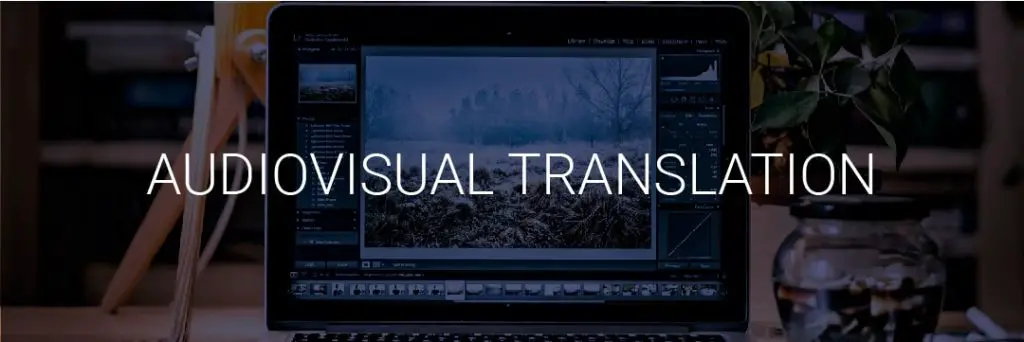
What Is Audio-Visual Translation?
Audiovisual translation (AVT) is the term used to refer to the transfer from one language to another of the verbal components contained in audiovisual works and products.
- Feature films, television programs, theatrical plays, musicals, opera, Web pages, and video games are just some examples of the vast array of audiovisual products available and that require translation. As the word suggests, audiovisuals are made to be both heard (audio) and seen (visual) simultaneously but they are primarily meant to be seen.
- There are ten types of audiovisual translation which can be united into two larger groups: revoicing and subtitling. Dubbing which is the most widely-spread type of revoicing is defined as a complete change of the original soundtrack into the soundtrack in the target language.
Overview Of The Use Of Audiovisual Translation in Cinematography
- We live in a society influenced greatly by the Media. With the appearance of new technologies, there appeared also new forms of international and intercultural communication which led to new forms of translation. Cinematography, as a part of the Media, has become one of the most widely-spread and influential forms of art. The translation of cinematographically products is called audiovisual translation though one can find many synonymous names as film translation, TV translation, screen translation, and many others. With the social phenomenon of globalization translators face the urgent need to translate films in short periods of time but in a high-quality way.
- Translation Studies theorists take the challenge to develop the theoretical background and frameworks of performing audiovisual translation and managing possible constraints and challenges. The aim of the article is to give a theoretical overview of audiovisual translation which is defined as the transfer from one language into another of the verbal components contained in audiovisual works and products. Thus, the object of the article is audiovisual translation from a translation studies perspective.
- Audiovisual translation is generally a translation of the verbal component of the video. Its main specific feature is the synchronization of verbal and nonverbal components. While dealing with audiovisual product translators do not work only with text but also with other aspects of media art which are of polyphonic nature. Thus, they work with dialogues/ comments, sound effects, images and atmosphere of the video.
What Are The Components To Be Translated In Audiovisual Translation?
- Verbal audio channel: dialogues, off-screen voices, songs;
- Nonverbal audio channel: music, sound effects, off-screen sounds;
- Verbal and visual channel: subtitles, signs, notes, inscriptions that appear on the screen;
- Nonverbal visual channel: picture on the screen.
- The co-existence of many semantic signs, which make up meaning, provides transfer from one semiologic complex into another in the audiovisual translation. In other words, two semiologic complexes are formed: the original and translation, the concept of equivalence acquires new interpretation and is greatly extended in reference to the multimedia character of translation. The equality of audiovisual translation is not only equivalence between the linguistic elements in two languages but also an adequate link between verbal and nonverbal structures separately in the original work and its translation.
- Free commentary is a kind of voice-over that focuses neither on the lip movements of the original text nor on the faithfulness of the target text and also not on the simultaneous mode of the performance but it’s free and often performed in different modes of translation which is usually complemented by different journalistic elements and text is covered partially or completely.
- Audio description transforms visual information into words, transfers the visual image into spoken language complementing in this way sounds and dialogues from the film. Audio description performs two functions. On one hand, it represents the audiovisual sign of the film which the blind have no opportunity to comprehend. On the other hand, it complements “the whole” with explanations of sounds which are understandable only through their connection with the images similarly to subtitles.
- Audio description includes inter-semiotic processes of transfer which are beyond language or cultural definitions of traditional concepts of translation. The effectiveness of audio description depends on the way all those signs are connected with each other.
- Audio description is a descriptive method of inserting explanation and description of the setting, characters, and action that take place in different audiovisual means when this information about these visual elements are not offered in the regular audio presentation. The golden rule of audio description suggests “describe what you see”.
- Audio description visualizes people, objects, actions and, which is more important, reflects the mood and emotional influence in the scene. Viewers should be able to have their own opinion and make own conclusions. Thus, it is very important not to change or interpret but always describe only the most significant features of the plot lines and actions.
- Audio description of high quality uses vocabulary and syntactical constructions which are oriented at the audience as well as at peculiarities of the described materials and searches to convey at least part if not all visual signs of the film or record. The language used in audio description should be exact, significant but not abstract
- Audiovisual translation is just one possible job specialization of many that we can find as professional translators related to translation and interpretation. Although the majority of audiovisual work is in English there are sometimes opportunities to do projects in German, French and other languages too.
Characteristics That Define Audiovisual Translation
Some of the typical characteristics that define audiovisual translation are speech and changing registers:
- Speech. With this characteristic, we refer to the ability to symbolize a previously translated natural and spontaneous dialogue. It might sound easy, but it is not. What is logical to one person in a certain context might seem totally out of place for another person. For that reason, a translator should be able to transfer written language on to the screen without adding strange expressions or demanding an unreasonable, unnatural effort on part of the character who is speaking.
- Changing registers. Contrary to the other specialized forms, audiovisual translation is characterized by suffering from changes in registers. Instead of working on a well-defined topic we are confronted with a great variety of possible registers. Among these are children’s programs, detective series, horror movies or documentary films on nature. One of audiovisual translation’s advantages is that it permits the translator to learn something new about any possible topic every day. That is why it is not surprising that translators often have a wide and pretty broad cultural and general knowledge.
Whilst I am telling you about the main characteristics, I would also like to mention some of its various modalities:
Modalities Of Audio-Visual Translation
- Synchronization and subtitles. There has always been a debate about which of the two is the more adequate and appropriate form. From my point of view, both have their pros and cons. Synchronization is the oral adaptation of an audiovisual document in which you do not have any traces of the original language. On some occasions though we will find cultural collocations that simply do not apply. In this case, it is necessary to blend in some kind of image or representation of the words in order to get the best results.
- On the other hand, the original language remains present in an audiovisual document that works with subtitles. The targeted language also is represented by subtitles underneath the visual sequences. Due to globalization and the wide availability to access movies and series from other countries, there is a cultural opening in which subtitles gain popularity over the more traditional synchronization.
- Overlaid voices. It is not unusual today to watch a television program in which you can hear the characters speak in their maternal language whilst you hear an overlaid voice that translates what has already been said. This kind of translation can especially be found in reality shows or documentaries, it is said the principal function of an overlaid voice is to introduce the viewer to a different culture and the theme of the programme.
- Audio description and subtitles for deaf people. This kind of audiovisual translation consists of subtitling for a hearing-impaired audience. That is why elements like the description of sounds – rather than just conversations between people – need to be included as well. This means that, for example, sighs will be indicated in a different manner from the conversational content-related subtitles. In some programs, they tend to mix this kind of translation with the interpretation of sign language.
- Localization. This is probably the most unknown form of audiovisual translation. It’s consists of translating and adapting all elements of websites, video games, software and other audiovisual documents to provide a better consumer approved product in a certain country it is exported to.
Useful Guidelines To Use During Audio-Visual Translation
The work of an audiovisual translator can be very gratifying and satisfying if you keep to the following criteria:
- Avoid the overuse of colloquialism;
- Translate cultural references adequately, and thus know the cultures of your working languages well.
- Translate onomatopoeia with equivalent sounds in the target language (if they exist)
- Become acquainted with sources out of the field (known experts in the area to which you are translating) as well as conventional sources. For example, if translating a text on the law it would be beneficial to contact any friends or contacts you have in those fields to help with any terminology you are not familiar with.
In some cases, the audiovisual translator has to synchronize the shown subtitles. However, this is not necessarily an easy task and sometimes there remain some mismatches in translations.
Just like in any other field of translation, there is always more than one possible translation for every text and that should be kept in mind when you are evaluating any translation’s quality.








Comment (1)
News XMC.pl
February 9, 2021Thanks, it has been bothering me that I couldnt get this to work right. Thanks again!
Comments are closed.